Disclaimer: As a Chewy and Amazon affiliate, I earn from qualifying purchases. This does not impact our reviews and comparisons.
Want to make your own homemade cat food?
As obligate carnivores, cats rely on animal foods for nutrition. Think meats and organs.
Unbalanced diets lead to nutrition deficiencies. Many homemade recipes fail to meet your cats needs.
In this article, I’ll help you with 3 homemade cat food recipes. I’ve made sure the nutrient balance is up to snuff.
That’s all there is to it.
So if you want to save money and make your cat healthier, let’s go…
I am not a veterinarian and I recommend seeking the advice of a vet for any further questions. This article is not intended as a replacement for medical advice.
3 Best Homemade Cat Food Recipes
I used food database software to make these recipes.
These meals are meet your cats needs for one day. Rotate each recipe with a 3 day menu.
Please share this with a vet before attempting this or any homemade cat food diet.
1. Beef Bonanza
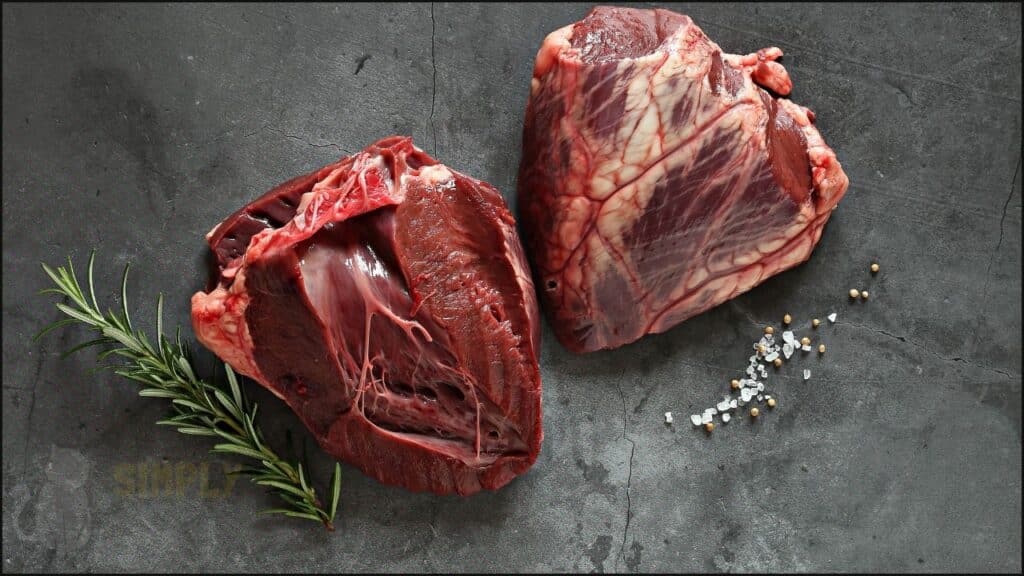
Ingredients
- 80g extra lean beef mince
- 20g beef heart
- 40g beef kidney
- 1 fresh oyster
- 1 extra large whole egg
- 1g ground egg shell
- 5ml extra virgin olive oil (or use a vitamin E supplement)
Instructions
- Weigh all the ingredients
- Add the beef mince to the bowl
- Finely chop the heart, kidney and oyster, adding to the mince
- Mix in the egg
- Wash the egg shell and pulverize using a pestle and mortar (or food processor)
- Add the extra virgin olive oil (or vitamin E supplement )
- Mix well and divide into servings
- (recommended) Cook the mixture in a pan on medium heat and cool before serving
Nutrition Breakdown
Macronutrients and Energy
- Energy: 340 kcal (1,425 kj)
- Protein: 45g (54%)
- Fat: 18g (46%)
- Carb: 0g (0%)
- Taurine: 90mg
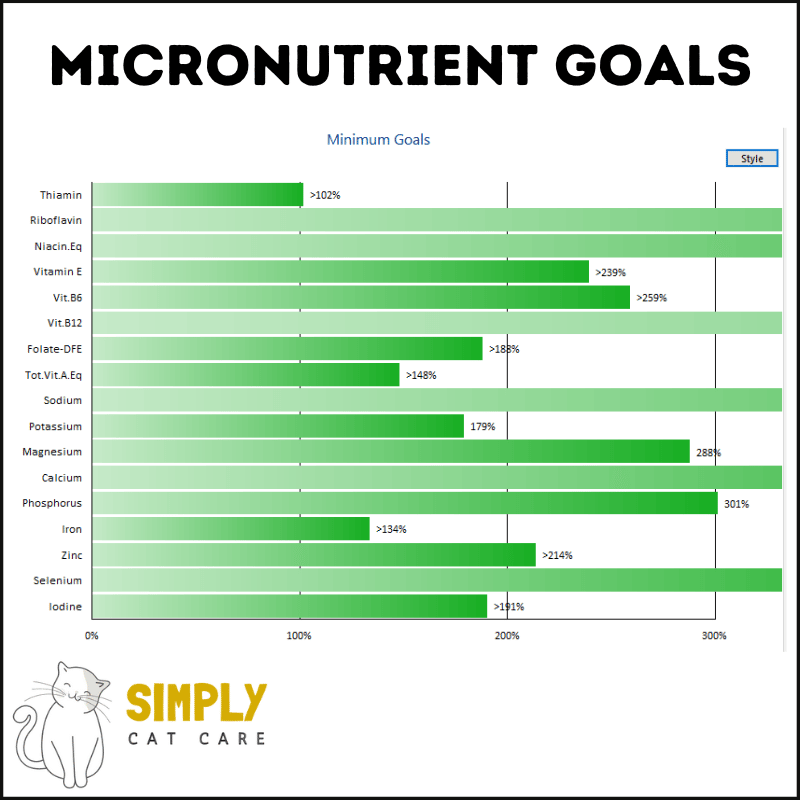
2. Seafood Lover
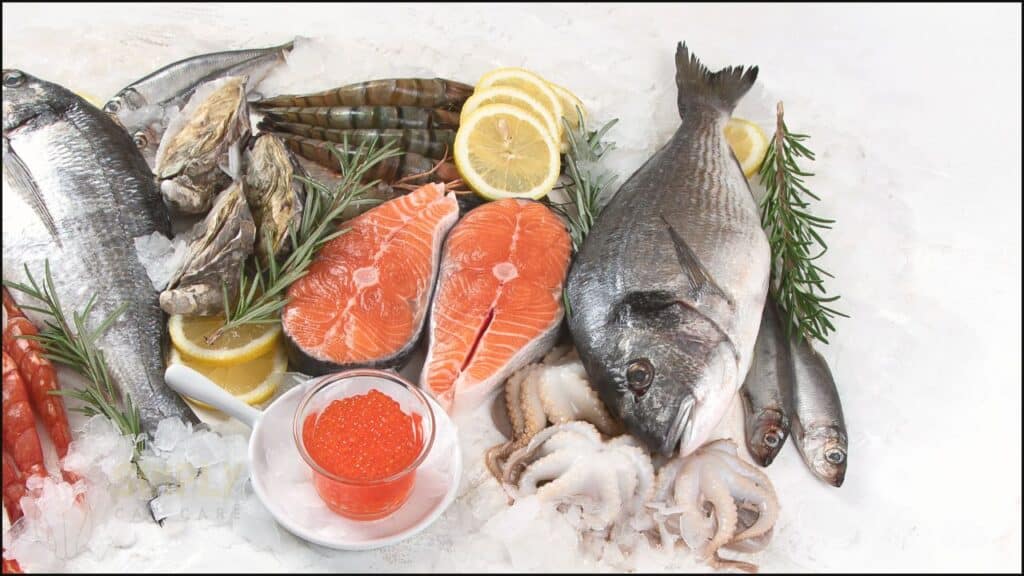
Ingredients
- 50g salmon without skin
- 2 king prawns
- 2 fresh oysters
- 30g green mussels
- 1 extra large whole egg
- 1g ground egg shell
- 1 drop thiamine supplement
- 5ml extra virgin olive oil (or use a vitamin E supplement)
Instructions
- Weigh all the ingredients
- Add the seafood to a food processor or chop finely, adding to a bowl
- Mix in the egg
- Wash the egg shell and pulverize using a pestle and mortar (or food processor)
- Add the extra virgin olive oil (or vitamin E supplement )
- Mix well and divide into servings
- (recommended) Cook the mixture in a pan on medium heat and cool before serving
- Add the thiamine supplement before serving
Nutrition Breakdown
Macronutrients and Energy
- Energy: 316 kcal (1,323 kj)
- Protein: 33g (42%)
- Fat: 20g (56%)
- Carb: 2g (2%)
- Taurine: 309mg
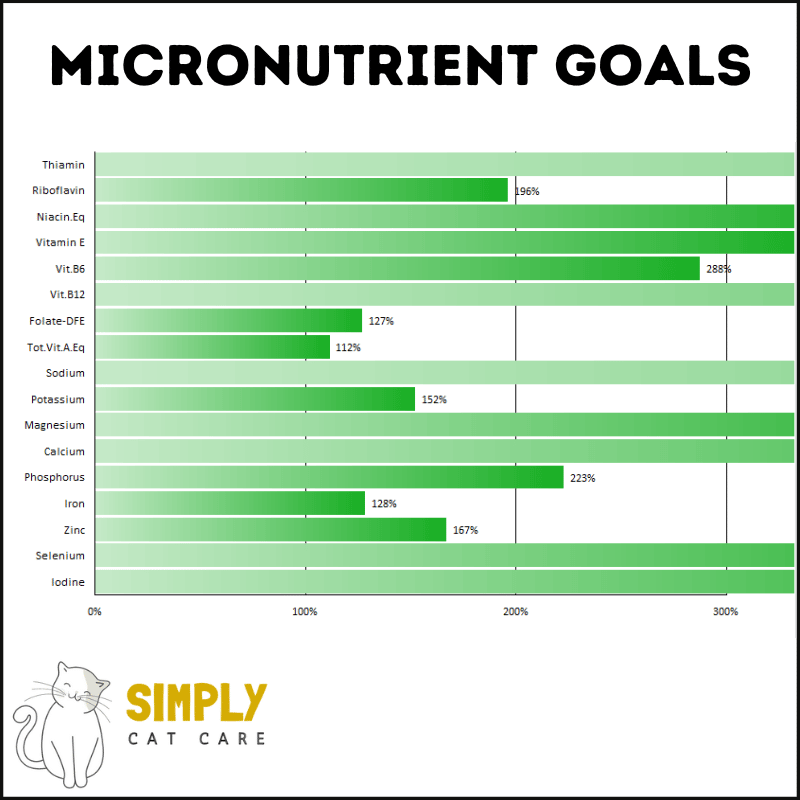
3. Chicken Combo
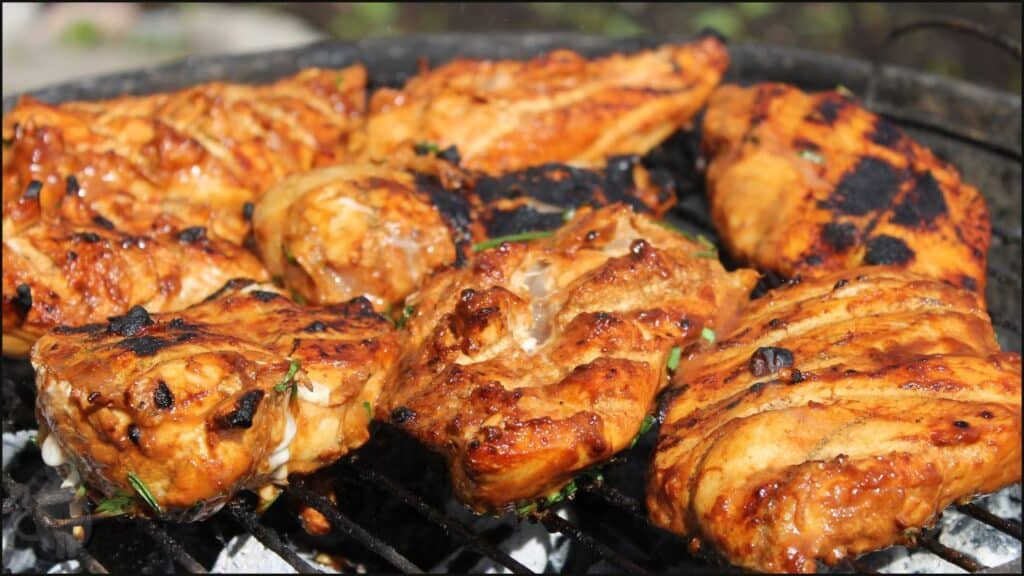
Ingredients
- 60g chicken thigh, trimmed, without skin
- 90g chicken breast, with skin
- 1 extra large whole egg
- 1g ground egg shell
- 1 drop thiamine supplement
Instructions
- Wash and weigh all the ingredients
- Add the chicken to a food processor or chop finely, adding to a bowl
- Mix in the egg
- Wash the egg shell and pulverize using a pestle and mortar (or food processor)
- Mix well and divide into servings
- (recommended) Cook the mixture in a pan on medium heat and cool before serving
- Add the thiamine supplement before serving
Nutrition Breakdown
Macronutrients and Energy
- Energy: 301 kcal (1,260 kj)
- Protein: 37.1g (50%)
- Fat: 17g (49%)
- Carb: 0.5g (1%)
- Taurine: 197mg
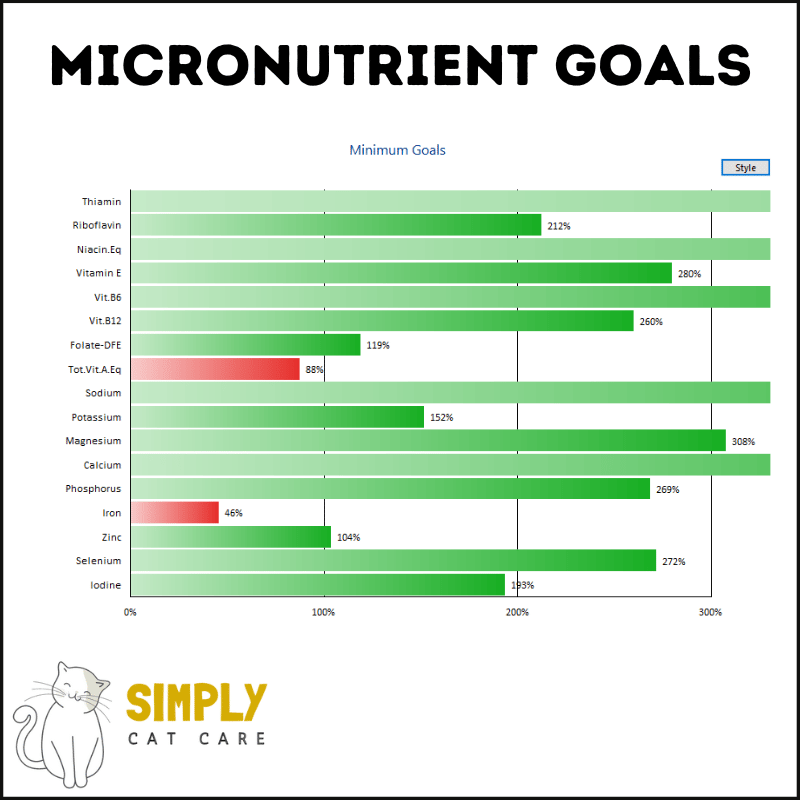
*the total vitamin A falls marginally short of min requirements with this meal. Iron falls short (not high in chicken based foods). However, if rotating between all three meals, your cat will get enough iron and Vitamin A in total.
Guide to Making Your Own Homemade Cat Food
So you want to feed your cat a homemade diet?
Awesome.
Here’s the deal:
Cat’s are obligate carnivores. That means they thrive off animal-based foods.
In fact they must consume animal based foods.
Cats have carnivore specialized bodies. Differences to humans include:
- Low levels of carbohydrate digesting enzymes
- A small digestive system not able to tolerate high fiber foods
- Low thirst levels
- Inability to get nutrients from plant-based foods
This includes Vitamin A, Vitamin D, essential fatty acids, and taurine
- Lack of liver enzymes for many plant foods (e.g. garlic, onion)
- High rates of gluconeogenesis (converting protein to sugar for energy)
- Inability to adapt to low protein diets
Here’s a comparison of a cats diet compared to us:
| Carb | Fat | Protein | |
| Wild cat diet | 1-2 | 30-68 | 30-68 |
| Human diet | 55 | 30 | 15 |
| Human low carb diet | 20 | 50 | 30 |
| Inuit diet | 8 | 50 | 42 |
Without the intervention of man, a cat can’t survive without animal-based foods.
Despite about 9,500 years of domestication (compared to 100,000 for dogs), cats are still carnivores.
Cats prefer a macronutrient sweet spot of 52% protein, 36%, and no more than 12% carbohydrate.
So with that out of the way, where do you start?
Well, let’s start by not using any old recipe homemade cat food recipe online…
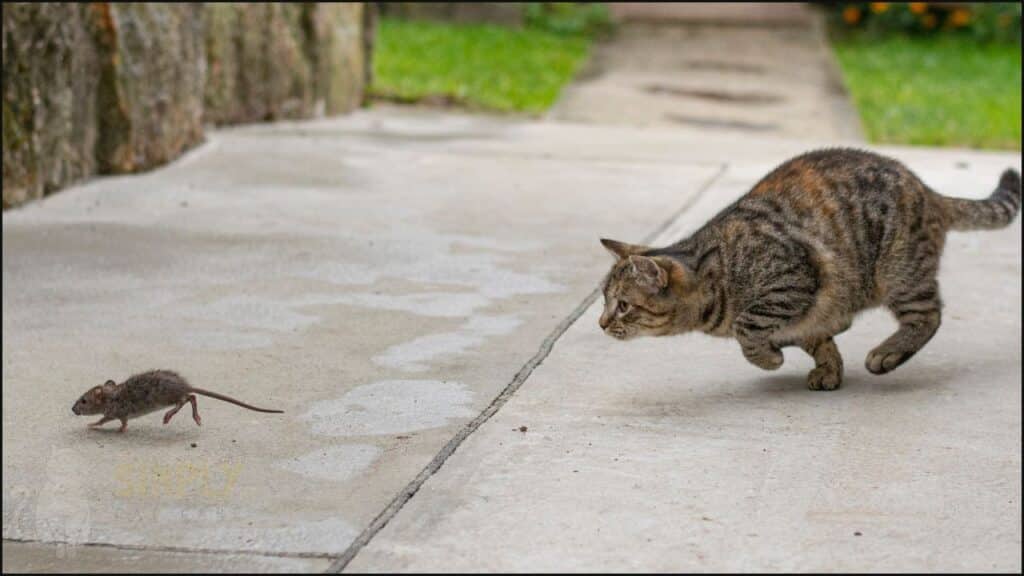
The Problem With Most Homemade Cat Food Recipes
If you type homemade cat food recipe into YouTube or Google you’ll see a huge range of content.
It’s seem tempting to those recipes. And they say ‘vet approved’!
Not so fast…
According to research:
Many online recipes are not well designed for a cat’s nutritional needs. In an evaluation study
- 113 of 114 cat food recipes give vague instructions
- 46 of 114 cat food recipes don’t provide any feeding directions.
- 8 of 114 cat food recipes contain toxic ingredients (e.g. garlic & leeks)
Most online cat food recipes aren’t well made falling short in nutrition.
A lack of thiamine causes cardiovascular system dysfunction and death.
Other recipes lack key micronutrients like zinc and calcium.
Some recipes include non-ground bones. Large bone pieces increase the risk of obstruction.
(I recommend pulverizing bones or egg shells for calcium).
Calcium is very important:
Young cats fed a diet without calcium develop:
- Neurological problems
- Impaired movement
- (extreme cases) Euthanization
An evaluation of homemade recipes found low levels of other micronutrients and high levels of phosphate which make many recipes inappropriate for cats with kidney disease.
Put simply, using anything found online is Russian Roulette for your cat.
What Ingredients Should I Put in Homemade Cat Food?
Use dietary recommendations for cats. This includes:
- The 2014 report from the Association of American Feed Control Officials (AAFCO)
- The National Research Council guide for cat owners
These reports show you what cats need for a balanced diet.
Here’s a snapshot of what cats need:
| RDA Kittens | RDA Adults | RDA Nursing | |
| Protein | 10g | 12.5g | 41g |
| Carbohydrate | 0g | 0g | 0g |
| Fat | 4g | 5.5g | 12g |
Frequently Asked Questions
Is Homemade Cat Food Better for Cats?
Homemade cat food offers a few advantages including:
- Being able to use exact amounts of different foods
- Using produce of your choosing
- Knowing what goes into your cats food
The downside is balancing the homemade cat food.
Most commercial cat foods meet your cats nutrient needs. Almost all online homemade cat food recipes do not.
What Homemade Food Can I Feed My Cat?
I’ve made 3 homemade cat food recipes in this article designed to meet a cats dietary needs. Use them on a three day rotating menu.
Be weary of vegan diets for cats.
One case report of a cat fed a vegan diet showed chronic urinary tract blockages. The diet contained a lot of cooked vegetables and plant-based foods.
Can I Feed My Cat Only Homemade Food?
Whilst it is possible (and my recipes help) I would use caution. Most recipes online don’t cut it.
If you’re cat isn’t fed a proper ratio of nutrients they suffer nutrient deficiencies.
What Can I Feed My Cat Instead of Cat Food?
You can use the recipes in this article to make your own homemade cat food. I recommend speaking with a vet about your cats dietary needs.
Some cats may need specific diets for a variety of health conditions (e.g. hyperthyroidism).
Are Scrambled Eggs Good for Cats?
Cats can eat eggs.
An egg has protein and micronutrients that help your cat meet their dietary needs.
However, scrambled eggs can contain ingredients cats can’t eat (e.g. onions).
Learn More:
How Do I Prepare Eggs for My Cat?
I recommend preparing eggs for cats without adding anything. Hard-boiling is a good way of preparing eggs for cats.
Make sure your heat eggs before serving to your cat.
And don’t throw away the eggshells, as they are a great source of calcium for cats when crushed down.
What Human Food Can Cats Eat Daily?
Cats are carnivores and can eat animal foods.
A cat doesn’t tolerate grains, legumes, fruit, and some vegetables. These foods are used as part of a humans diet, but aren’t suitable for cats.
Is Canned Tuna Good for Cats?
No.
The mercury content in one tin of tuna is too much for a cat.
As an occasional treat a small amount of tuna is ok, but not every day.
Learn More:
Is Sweet Potato Good for Cats?
No.
Sweet potato is high in carbohydrate. Cats do not tolerate high amounts of carbohydrate in the diet.
A cat has zero dietary need for carbs.
Sweet potato offers the nutrient beta carotene. This is of no use to cats, as they can’t convert it to active vitamin A.
Learn More:
Do I Need to Add Supplements to Homemade Cat Food?
It depends on how well balanced the food is.
Some nutrients are harder to get depending on the foods used in meal preparation.
For example, thiamine (vitamin B1) is difficult to come by in a lot of foods. Consider a supplement for this nutrient.
The temptation is to toss a multivitamin in and call it day. Many contain ingredients not suitable for cats though.
For example, iron, copper, and magnesium oxide are cheap supplements that aren’t well absorbed.
Here are some supplements I’ve found worth consideration:
- Thiamine drops
- Omega 3 supplement (especially if not using salmon in the diet)
Is Rice Good for Cats?
No.
Rice is high in carbohydrate. Cats have no dietary need for carbs.
Cats eat mice, not rice.
Many homemade cat food recipes online arbitrarily add in rice. There’s no need for that.
Rice bran also reduces the absorption of taurine.
Learn More:
Can I Feed My Cat Just Chicken?
No. Chicken isn’t a complete food by itself.
A cat suffers nutritional secondary hyperparathyroidism with a ‘chicken only’ diet.
This is due to a lack of calcium among other nutrients.
As an occasional snack, cats can eat chicken by itself. Long term, you must provide a balanced diet for health.
What Is a Cats Natural Diet?
Cats are obligate carnivores. Their natural diet is small prey including mice, insects, and birds.
Can My Cat Eat Oatmeal?
In small amounts yes. However, oats contain high amounts of carbs, which cats have no dietary need for.
Researchers suggest a carbohydrate ceiling effect of 300kj/71kcal (or about 17g of carbohydrate).
After eating this amount of carbohydrate, cats can reject further food or beg for other foods higher in protein.
Is It Cheaper to Make Your Own Cat Food?
It depends on the ingredient sources and cat food you intend to replace.
Most organ meats (e.g. beef hearts) are cheaper than meats used for humans (e.g. sirloin steak).
Grass-fed produce can attract a higher price.
I estimate the recipes in this guide will cost between $2-5 per day depending on sources.
What Can I Feed My Cat if I Have No Cat Food?
In a pinch, you can offer your cat any plain animal based foods. This includes chicken, eggs, beef, and fish.
You can also offer cats small amounts of milk (up to 85ml per day).
Learn More:
Is It Ok to Cook for Your Cat?
Yes, I recommend cooking your cat food.
Although it is possible to feed your cat raw food, there’s no benefit and the potential for contamination.
Raw egg whites contain a protein called avidin which binds to biotin. The egg itself may be a source of salmonella contamination.
What Are the Signs of a Healthy Cat?
The general signs of a healthy cat are:
- Able to clean themselves with grooming
- Regular use of the litter box
- Clear coat without sores.
Cats need to maintain a healthy weight. Obese cats are at a higher risk of diabetes.
Keep in mind that cats disguise pain in the wild to not attract the attention of predators.
Even if you think your cat is healthy, always get regular vet check-ups.
Learn More:
Should I Add Anything for Hairball Control?
Research has looked into a variety of fiber sources for hairball control.
They include:
- Powdered cellulose
- Beet pulp
- Sugarcane fiber
One research paper found 20% sugarcane fiber prevented the formation of large hairballs. These are the most likely to cause discomfort and vomiting.
Conclusion
Making your own homemade cat food can save cost and be healthier for your cat.
The problem is most recipes online suck.
They don’t show how they meet a cats dietary needs at all. Some include ingredients toxic to cats (even the vet recommended ones).
Consult with your vet before attempting any homemade cat food diet.
